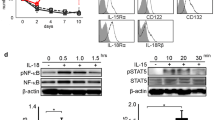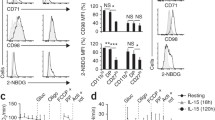Abstract
Adoptive transfer of immune cells, such as T lymphocytes and NK cells, has potential to control cancer growth. However, this can be counteracted by immune escape mechanisms within the tumor microenvironment, including those mediated by reactive oxygen species (ROS). Here, we determined the levels of anti-oxidant molecules in NK cells and their capacity to overcome ROS-induced immune suppression. We investigated the effect of H2O2 on resting NK cells, IL-2-activated NK cells and NK cells expanded by coculture with the K562 leukemia cell line genetically modified to express membrane-bound IL-15 and 4-1BB ligand (K562-mb15-41BBL). Expression of anti-oxidant and anti-apoptotic genes was evaluated by expression array, and protein levels of anti-oxidant molecules by Western blot. Activated NK cells, IL-2-activated NK cells and NK cells expanded by K562-mb15-41BBL were significantly more resistant to H2O2-induced cell death than resting NK. Thioredoxin-1 (TXN1) and peroxiredoxin-1 (PRDX1) were also up-regulated in activated NK cells. Moreover, H2O2-induced cell death after IL-2 activation was significantly induced in the presence of an anti-TXN1-neutralising antibody. Collectively, these data document that activated NK cells can resist to H2O2-induced cell death by up-regulation of TXN1.





Similar content being viewed by others
Abbreviations
- 7-AAD:
-
7-Aminoactinomycin D
- Akt:
-
Protein kinase B
- ECL:
-
Enhanced chemiluminescence
- Erk:
-
Extracellular signal–regulated kinase
- Expanded NK:
-
NK cells expanded with K562 leukemia cell line genetically modified to express membrane-bound IL-15 and 4-1BB ligand for 7 days
- IL-2 NK:
-
NK cells activated by several doses of IL-2 for 7 days
- K562-mb15-41BBL:
-
K562 leukemia cell line genetically modified to express membrane-bound IL-15 and 4-1BB ligand
- PRDX1:
-
Peroxiredoxin-1
- Resting NK:
-
Resting NK cells
- ROS:
-
Reactive oxygen species
- SOD:
-
Superoxide dismutase
- TXN1:
-
Thioredoxin-1
References
Robert C, Long GV, Brady B, Dutriaux C, Maio M, Mortier L et al (2015) Nivolumab in previously untreated melanoma without BRAF mutation. N Engl J Med 372:320–330
Brahmer J, Reckamp KL, Baas P, Crino L, Eberhardt WE, Poddubskaya E et al (2015) Nivolumab versus docetaxel in advanced squamous-cell non-small-cell lung cancer. N Engl J Med 373:123–135
Mimura K, Kua LF, Shiraishi K, Kee Siang L, Shabbir A, Komachi M et al (2014) Inhibition of mitogen-activated protein kinase pathway can induce upregulation of human leukocyte antigen class I without PD-L1-upregulation in contrast to interferon-gamma treatment. Cancer Sci 105:1236–1244
Cheng M, Chen Y, Xiao W, Sun R, Tian Z (2013) NK cell-based immunotherapy for malignant diseases. Cell Mol Immunol 10:230–252
Kalos M, June CH (2013) Adoptive T cell transfer for cancer immunotherapy in the era of synthetic biology. Immunity 39:49–60
Mimura K, Kamiya T, Shiraishi K, Kua LF, Shabbir A, So J et al (2014) Therapeutic potential of highly cytotoxic natural killer cells for gastric cancer. Int J Cancer 135:1390–1398
Izawa S, Kono K, Mimura K, Kawaguchi Y, Watanabe M, Maruyama T et al (2011) H(2)O(2) production within tumor microenvironment inversely correlated with infiltration of CD56(dim) NK cells in gastric and esophageal cancer: possible mechanisms of NK cell dysfunction. Cancer Immunol Immunother 60:1801–1810
Kono K, Salazar-Onfray F, Petersson M, Hansson J, Masucci G, Wasserman K et al (1996) Hydrogen peroxide secreted by tumor-derived macrophages down-modulates signal-transducing zeta molecules and inhibits tumor-specific T cell-and natural killer cell-mediated cytotoxicity. Eur J Immunol 26:1308–1313
Hansson M, Asea A, Ersson U, Hermodsson S, Hellstrand K (1996) Induction of apoptosis in NK cells by monocyte-derived reactive oxygen metabolites. J Immunol 156:42–47
Martner A, Aurelius J, Rydstrom A, Hellstrand K, Thoren FB (2011) Redox remodeling by dendritic cells protects antigen-specific T cells against oxidative stress. J Immunol 187:6243–6248
Gostner JM, Becker K, Fuchs D, Sucher R (2013) Redox regulation of the immune response. Redox Rep 18:88–94
Thoren FB, Romero AI, Hermodsson S, Hellstrand K (2007) The CD16-/CD56bright subset of NK cells is resistant to oxidant-induced cell death. J Immunol 179:781–785
Bernstein ZP, Porter MM, Gould M, Lipman B, Bluman EM, Stewart CC et al (1995) Prolonged administration of low-dose interleukin-2 in human immunodeficiency virus-associated malignancy results in selective expansion of innate immune effectors without significant clinical toxicity. Blood 86:3287–3294
Meropol NJ, Barresi GM, Fehniger TA, Hitt J, Franklin M, Caligiuri MA (1998) Evaluation of natural killer cell expansion and activation in vivo with daily subcutaneous low-dose interleukin-2 plus periodic intermediate-dose pulsing. Cancer Immunol Immunother 46:318–326
Fujisaki H, Kakuda H, Shimasaki N, Imai C, Ma J, Lockey T et al (2009) Expansion of highly cytotoxic human natural killer cells for cancer cell therapy. Cancer Res 69:4010–4017
Mimura K, Shiraishi K, Mueller A, Izawa S, Kua LF, So J et al (2013) The MAPK pathway is a predominant regulator of HLA-A expression in esophageal and gastric cancer. J Immunol 191:6261–6272
Ando T, Mimura K, Johansson CC, Hanson MG, Mougiakakos D, Larsson C et al (2008) Transduction with the antioxidant enzyme catalase protects human T cells against oxidative stress. J Immunol 181:8382–8390
Test ST, Weiss SJ (1984) Quantitative and temporal characterization of the extracellular H2O2 pool generated by human neutrophils. J Biol Chem 259:399–405
Harlin H, Hanson M, Johansson CC, Sakurai D, Poschke I, Norell H et al (2007) The CD16–CD56(bright) NK cell subset is resistant to reactive oxygen species produced by activated granulocytes and has higher antioxidative capacity than the CD16 + CD56(dim) subset. J Immunol 179:4513–4519
Mellqvist UH, Hansson M, Brune M, Dahlgren C, Hermodsson S, Hellstrand K (2000) Natural killer cell dysfunction and apoptosis induced by chronic myelogenous leukemia cells: role of reactive oxygen species and regulation by histamine. Blood 96:1961–1968
Takahashi A, Kono K, Ichihara F, Sugai H, Amemiya H, Iizuka H et al (2003) Macrophages in tumor-draining lymph node with different characteristics induce T-cell apoptosis in patients with advanced stage-gastric cancer. Int J Cancer 104:393–399
Hole PS, Zabkiewicz J, Munje C, Newton Z, Pearn L, White P et al (2013) Overproduction of NOX-derived ROS in AML promotes proliferation and is associated with defective oxidative stress signaling. Blood 122:3322–3330
Nadeem A, Chhabra SK, Masood A, Raj HG (2003) Increased oxidative stress and altered levels of antioxidants in asthma. J Allergy Clin Immunol 111:72–78
Kaur N, Naga OS, Norell H, Al-Khami AA, Scheffel MJ, Chakraborty NG et al (2011) T cells expanded in presence of IL-15 exhibit increased antioxidant capacity and innate effector molecules. Cytokine 55:307–317
Yu TK, Caudell EG, Smid C, Grimm EA (2000) IL-2 activation of NK cells: involvement of MKK1/2/ERK but not p38 kinase pathway. J Immunol 164:6244–6251
Malek TR, Castro I (2010) Interleukin-2 receptor signaling: at the interface between tolerance and immunity. Immunity 33:153–165
Mougiakakos D, Johansson CC, Jitschin R, Bottcher M, Kiessling R (2011) Increased thioredoxin-1 production in human naturally occurring regulatory T cells confers enhanced tolerance to oxidative stress. Blood 117:857–861
Izawa S, Mimura K, Watanabe M, Maruyama T, Kawaguchi Y, Fujii H et al (2013) Increased prevalence of tumor-infiltrating regulatory T cells is closely related to their lower sensitivity to H2O2-induced apoptosis in gastric and esophageal cancer. Cancer Immunol Immunother 62:161–170
Kim JH, Chu SC, Gramlich JL, Pride YB, Babendreier E, Chauhan D et al (2005) Activation of the PI3K/mTOR pathway by BCR-ABL contributes to increased production of reactive oxygen species. Blood 105:1717–1723
Rhee SG, Yang KS, Kang SW, Woo HA, Chang TS (2005) Controlled elimination of intracellular H(2)O(2): regulation of peroxiredoxin, catalase, and glutathione peroxidase via post-translational modification. Antioxid Redox Signal 7:619–626
Siernicka M, Winiarska M, Bajor M, Firczuk M, Muchowicz A, Bobrowicz M et al (2015) Adenanthin, a new inhibitor of thiol-dependent antioxidant enzymes, impairs the effector functions of human natural killer cells. Immunology 146:173–183
Okuyama H, Yoshida T, Son A, Oka S, Wang D, Nakayama R et al (2009) Thioredoxin binding protein 2 modulates natural killer T cell-dependent innate immunity in the liver: possible link to lipid metabolism. Antioxid Redox Signal 11:2585–2593
Mitsui A, Hamuro J, Nakamura H, Kondo N, Hirabayashi Y, Ishizaki-Koizumi S et al (2002) Overexpression of human thioredoxin in transgenic mice controls oxidative stress and life span. Antioxid Redox Signal 4:693–696
Waldmann TA (2006) The biology of interleukin-2 and interleukin-15: implications for cancer therapy and vaccine design. Nat Rev Immunol 6:595–601
Becknell B, Caligiuri MA (2005) Interleukin-2, interleukin-15, and their roles in human natural killer cells. Adv Immunol 86:209–239
Fehniger TA, Cooper MA, Caligiuri MA (2002) Interleukin-2 and interleukin-15: immunotherapy for cancer. Cytokine Growth Factor Rev 13:169–183
Jin DY, Chae HZ, Rhee SG, Jeang KT (1997) Regulatory role for a novel human thioredoxin peroxidase in NF-kappaB activation. J Biol Chem 272:30952–30961
Nakamura H, Masutani H, Yodoi J (2006) Extracellular thioredoxin and thioredoxin-binding protein 2 in control of cancer. Semin Cancer Biol 16:444–451
Nilsson J, Soderberg O, Nilsson K, Rosen A (2000) Thioredoxin prolongs survival of B-type chronic lymphocytic leukemia cells. Blood 95:1420–1426
Backman E, Bergh AC, Lagerdahl I, Rydberg B, Sundstrom C, Tobin G et al (2007) Thioredoxin, produced by stromal cells retrieved from the lymph node microenvironment, rescues chronic lymphocytic leukemia cells from apoptosis in vitro. Haematologica 92:1495–1504
Waldhauer I, Steinle A (2008) NK cells and cancer immunosurveillance. Oncogene 27:5932–5943
Acknowledgements
This work was supported by a Clinician Scientist Award (CSA) and Clinician Scientist-Individual Research Grant (CS-IGR) from the National Medical Research Council of Singapore. We would like to thank Dr. Dario Campana (National University of Singapore, Singapore) for providing us with the K562-mb15-41BBL cell line.
Author information
Authors and Affiliations
Corresponding author
Ethics declarations
Conflict of interest
The authors declare that they have no conflict of interest.
Additional information
K. Mimura and L.-F. Kua equally contributed to this study.
Rights and permissions
About this article
Cite this article
Mimura, K., Kua, LF., Shimasaki, N. et al. Upregulation of thioredoxin-1 in activated human NK cells confers increased tolerance to oxidative stress. Cancer Immunol Immunother 66, 605–613 (2017). https://doi.org/10.1007/s00262-017-1969-z
Received:
Accepted:
Published:
Issue Date:
DOI: https://doi.org/10.1007/s00262-017-1969-z




